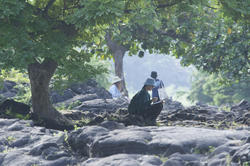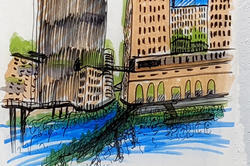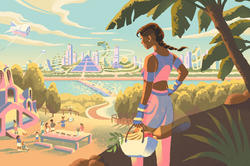A Wintersession global studies course led by Lucy Spelman and Andrea Dezsö considers the important role that artists and designers can play in environmental conservation.
RISD Symposium Catalyzes New Thinking About Climate Crisis

An international panel of artists, architects, educators and urban designers came together in early March for Sensing the Environment: Evidence, Narrative, Appearance, a multidisciplinary symposium and parallel exhibition organized by recently hired Assistant Professor of Architecture Amelyn Ng. The innovative event, she explains, “aimed to decenter visual mediums of quantification and extraction and catalyze discussions about how climate agency might be exercised through visual research, acts of design and creative practice.”
“The arts bring forth counter-practices, mobilize memories and actions, and dismantle traditional aesthetics of ‘nature’ in the face of the climate emergency.”
Ng invited speakers whose perspectives depart from what she describes as “Eurocentric, Enlightenment-era, solutions-based approaches” to the climate crisis. “The arts bring forth counter-practices, mobilize memories and actions, and dismantle traditional aesthetics of ‘nature’ in the face of the climate emergency,” she adds.


The opening speaker, Brooklyn-based artist sTo Len, explores NYC’s polluted waterways in a rowboat he purchased on Craigslist for $100 and creates prints and art installations using the toxic water and trash he collects. Currently serving as artist-in-residence with the New York City Department of Sanitation, he describes his work as “an experimental collaboration with nature and a site of discourse on environmentalism and art activism.”

Len’s presentation was followed by an equally compelling talk by fellow New Yorker LinYee Yuan, founder and editor of MOLD. The publication explores how designers can address the coming food crisis by creating products and systems that will help feed the nine billion people who will be living on Earth by the year 2050. “It’s not about what we will eat, but how we will eat,” Yuan says, “and the question of how is key to all kinds of crises we face. How demands interdisciplinary dialogue and requires us to understand our interconnections.”


Yuan also touched on the importance of care as a tenet of every responsible design practice, a notion that Houston-based landscape architect and urban designer Maggie Tsang drove home later in the day. Tsang sees tending as a form of creative practice and works with her team to build community awareness around its importance via public installations like Pine in the Sand and Prairie Plots. “There can be no separation between the natural and the built environment,” she explains, “and the concept of environmental stability is an illusion.”
“New media bring forth different types of evidence about climate histories and enable new forms of environmental justice.”
South American architect Paulo Tavares is also questioning environmental stability by examining the devastation of the Amazon rainforest in Brazil and the Indigenous people who stewarded it until they were removed by government forces in the 1960s. He presented satellite photographs revealing the footprints of Chavantes villages wiped out by Brazil’s military. “New media bring forth different types of evidence about climate histories and enable new forms of environmental justice,” he says.

Tavares explained how Brazil’s drive for “modernization” and “development” camouflaged its underlying quest to colonize the land, destroy existing villages and forests and supplant them with industrial soy plantations. “So, it’s not only a question of environmental repair, but also one of historical reparations,” he notes.
“Students are testing untraditional tools as a way to challenge traditional discourse and present a counter-narrative.”
Scholar/architect Linda Schilling Cuellar of practice AHORA presented immersive work by her students at UDLA in Santiago, Chile, who are using new mediums, including video games, to examine socioenvironmental conflicts. One project highlighted a theater under construction at Panguipulli Lake, where raw sewage is being dumped nearby, and another focused on a hydroelectric damming project that would displace Indigenous people and endangered species like the black woodpecker. “Students are testing untraditional tools as a way to challenge traditional discourse and present a counter-narrative,” she says.

Here in the US, architect and urban designer Gabriel Cuéllar of Cadaster is utilizing tools and techniques that make the invisible visible and challenge the idea underlying most modern-day development: that each privately owned plot of land is an island unto itself. He uses LiDAR laser-imaging tools and interactive maps that allow architects and urban planners to “see the world through half-closed eyes,” bringing to light patterns and underlying environmental aspects that transcend property lines and political boundaries.

Finally, scientist/artist Felipe Shibuya, who is currently serving as the Hyundai Biological Programs Fellow at RISD’s Edna W. Lawrence Nature Lab, delved further into the question of the invisible, noting how little of the color spectrum is visible to human eyes and how important microscopic organisms are to maintaining the health of our planet. “The colors of nature always have meaning,” he says, “and my work focuses on trying to understand what we cannot see.”
—Simone Solondz / top photo by Zeyuan Ren
March 13, 2023


